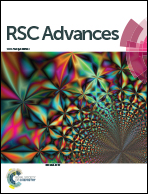Rapid and selective electrochemical transformation of ammonia to N2 by substoichiometric TiO2-based electrochemical system†
Abstract
In this study, we have developed a continuous-flow electrochemical system towards the rapid and selective conversion of ammonia to N2, based on a tubular substoichiometric titanium dioxide (Ti4O7) anode and a Pd–Cu co-modified Ni foam (Pd–Cu/NF) cathode, both of which are indispensable. Under the action of a suitable anode potential, the Ti4O7 anode enables the conversion of Cl− to chloride radicals (Cl˙), which could selectively react with ammonia to produce N2. The anodic byproducts, e.g. NO3−, were further reduced to N2 at the Pd–Cu/NF cathode. EPR and scavenger experiments confirmed the dominant role of Cl˙ in ammonia conversion. Complete transformation of 30 mg L−1 ammonia could be obtained over 40 min of continuous operation under optimal conditions. The proposed electrochemical system also exhibits enhanced oxidation kinetics compared to conventional batch systems. This study provides new insights into the rational design of a high-performance electrochemical system to address the challenging issue of ammonia pollution.



 Please wait while we load your content...
Please wait while we load your content...